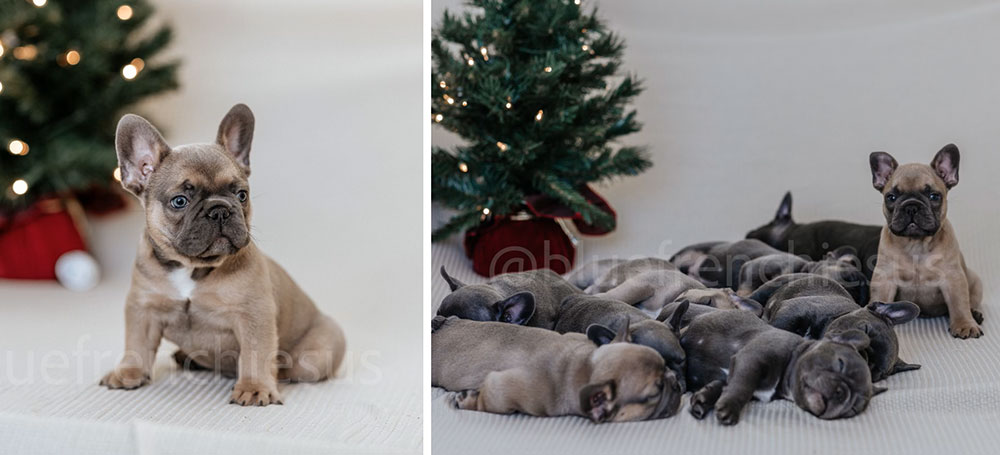GENERAL APPEARANCE: A sturdy, compact, solid, small dog with good bone and a short, smooth coat. No point exaggerated, balance is essential. Dogs showing respiratory distress are highly undesirable.
CHARACTERISTICS: Full of courage, yet with clown-like qualities. Bat ears and short tail characteristics are features of the breed.
TEMPERAMENT: Vivacious, deeply affectionate & intelligent.
HEAD AND SKULL: Head, square in appearance and in proportion to the Dog’s size. Skull nearly flat between the ears with a domed forehead. The skin covering the skull and forehead should be supple enough to allow fine wrinkling when the dog is alert. Well-defined muzzle, broad, deep and set back. Muscles of cheeks well developed. Stop well defined. Lower jaw deep, square, broad, slightly undershot and turned up. Nose black and wide, relatively short, with open nostrils and line between well defined. Lips black, thick, meeting each other in centre, completely hiding teeth Upper lip covers lower on each side with plenty of cushion, never so exaggerated as to hang too much below level of lower jaw.
EYES: Preferably dark and matching. Moderate size, round, neither sunken nor prominent, showing no white when looking straight forward; set relatively wide apart and on the same level as the stop.
EARS: ‘Bat ears’, of medium size, wide at base, rounded at top; set high, carried upright and parallel, a sufficient width of skull preventing them being too close together; skin soft and fine, orifice as seen from the front, showing entirely. The opening to the ear canal should be wide and open.
MOUTH: Slightly undershot. Teeth sound and regular, but not visible when the mouth is closed. Tongue must not protrude.
NECK: Powerful, well arched and thick, of moderate length.
FOREQUARTERS: Legs set wide apart, straight -boned, strong, muscular and short.
BODY: Cobby, muscular and well rounded with deep, wide brisket and ribs well sprung. Strong, gently roached back. Good ‘cut up‘. The body, while broader at the shoulders, should narrow slightly beyond the ribs to give definition to the relatively short thick strong muscular loin.
HINDQUARTERS: Legs strong, muscular and relatively longer than forelegs, with moderate angulation. Absolute soundness is essential. Hocks well let down.
FEET: Small, compact and placed in continuation of line of leg, with absolutely sound pasterns. Hind feet should be rather longer than forefeet. Toes compact; well knuckled, nails short, thick and preferably black.
TAIL: Undocked, short, set low, thick at root, tapering quickly towards tip, preferably straight and long enough to cover anus. Never curling over back nor carried gaily.
GAIT/MOVEMENT: Free and flowing. Soundness of movement of the utmost importance
COAT: Texture fine, smooth, lustrous, short and close.
COLOUR:The only correct colours are: Brindle, Fawn & Pied.
Brindle – Colour pattern caused by a mixture of black hairs and fawn hairs. White markings permitted provided that brindle predominates. Eye rims, eyelashes and lips black.
Fawn – Clear, self-coloured fawn with or without a black mask. White markings permitted, provided that fawn predominates. Cream and red shades less desirable. Eye rims, eyelashes and lips black.
Pied – Brindle Pied: White predominates with brindle patches. (The brindle as defined above). Fawn Pied: White predominates with fawn patches.
Whites are classified with pieds for show purposes. In pieds, eye rims, eyelashes and lips should preferably be black. Any white in the above colours should be clear with no ticking or spots.
SIZE: Ideal weight: Dogs: 12.5 kg (28 lb.); Bitches: 11kg (24 lb.).
FAULTS: Any departure from the foregoing points should be considered a fault and the seriousness with which the fault should be regarded should be in exact proportion to its degree and its effect upon the health and welfare of the dog.
NOTE:
• Colour information – Blue Frenchies, among other colour Frenchies have bad names in the Frenchie world. A lot of people call these colours ‘undesirable’ and there are myths that these colours affect the health of the dogs or makes them more prone to health issues. We, among a lot of other reputable breeders out there, feel this is hearsay as there has been no evidence what so ever produced by anyone to prove this. They’re no more prone to any health issues than a Fawn or Brindle Frenchie. This doesn’t mean a Blue Frenchie will never have any health issues, they are at the same risk of skin and coat issues as all other colour French Bulldogs or Dogs in general. The Blue (d-locus) gene is natural in these dogs and isn’t something that has been scientifically added into lines over a period of time. As responsible breeders, we take extra care in ensuring we are breeding healthy dogs and we DNA test all our Dogs for hereditary conditions to ensure they are clear of these.
• Male animals should have two apparently normal testicles fully descended into the scrotum.
• Size – the Kennel Club Breed Standard is a guide and description of the ideal for the breed; the Size as described does not imply that a dog will match the measurements given (height or weight). A dog might be larger or smaller than the Size measurements stated in the Breed Standard.
General
French bulldogs are classed as a small breed dog. Their life expectancy is 8-10 years. They are very playful and affectionate, as well as being loyal, loving and wonderful companion dogs. French Bulldogs can be a challenge to train due to their willful and stubborn nature. They require patience, repetition and early socialisation.
Health
As a result of the compacted airway of the French bulldog, they may develop an inability to effectively regulate temperature. While a regular canine may suffer to some degree from the heat, to a Frenchie it may be lethal. It is imperative that they be protected from temperature extremes at all times, and that they always have access to fresh water and shade. As they’re a brachycephalic breed, French Bulldogs are banned by several commercial airlines due to the numbers that have died while in the air. This is because dogs with snub noses find it difficult to breathe when they are hot and stressed out; the cargo space in an aircraft can rise as high as 30 °C (86 °F) when waiting on the runway.
French bulldogs can also suffer from an assortment of back and spinal diseases, most of which are probably related to the fact that they were selectively chosen from the dwarf examples of the bulldog breed. This condition is also referred to as chondrodysplasia.
Patellar luxation is the dislocation (slipping) of the patella (kneecap). In dogs, the patella is a small bone that shields the front of the stifle joint. This bone is held in place by ligaments. As the knee joint is moved, the patella slides in a groove in the femur. The kneecap may dislocate toward the inside (medial) or outside (lateral) of the leg. This condition may be the result of injury or congenital deformities (present at birth). Patellar luxation can affect either or both legs.
French bulldogs have a tendency towards eye issues. Cherry eye, an everted third eyelid, has been known to occur, although it is more common in English Bulldogs and Pugs. Glaucoma, retinal fold dysplasia, corneal ulcers and juvenile cataracts are also conditions that have been known to affect French bulldogs. The skin folds under the eyes of the French bulldog should be cleaned regularly and kept dry. Tearstains are common on lighter-colored dogs.
French bulldogs frequently require artificial insemination or caesarean section to give birth, with over 80% of litters delivered this way. As well, many French bulldog stud dogs are incapable of naturally breeding. This is because French Bulldogs have very slim hips, making the male unable to mount the female to reproduce naturally. Typically, breeders must undertake artificial insemination of female dogs.
Other Information
With their big, bulbous eyes and snub nose, the French Bulldog is arguably one of the most adorable dogs around
Before you dash out and buy a French Bulldog, it is important that you read up about the breed as best you can. Though tempting, try and avoid the cheapest selling price, as this can be a sign of poor breeding. A well-bred Frenchie will be hard work and expensive for the breeder, if they’re doing it properly, and will be priced accordingly. Be wary of puppy farmers, or any ‘breeder’ that seems to solely be out for financial gain. Puppies from these people will be in very poor health, and will likely have a whole host of medical and behavioural problems. A good place to look for breeders is at your nearest breed club, the Kennel Club website. You should also go and speak to some experts on the breed, and meet some adult dogs. It may seem pedantic, but quite a number of would-be French Bulldog owners have never actually seen one in the flesh!
There are also some important points to consider once you’ve found a breeder and decided to buy a Frenchie. French Bulldogs, as any puppies, are incredibly hard work. They can take up to two years to fully mentally mature, and will require a huge amount of attention and patience. They can be rather difficult to train due to their stubborn nature. If you work all day away from home, you should not get a French Bulldog, as they don’t cope well with being left long periods of time on their own, and can consequently become extremely destructive. They also cry extremely loudly when left alone, which might not be something the neighbours will enjoy! The ideal French Bulldog owner will work from home or be retired, as they require someone with them most hours of the day. French Bulldogs love human companionship, and will want to be involved in every aspect of your life. They are extremely friendly though, so don’t expect too much loyalty if someone else comes in with a biscuit!
Owning a French Bulldog is also not without its ups and downs. For a shorthaired breed, Frenchies shed. They also shed year round, so invest in a good quality grooming brush if you wish to save your carpets and furniture! Another, slightly more unpleasant, fact about French Bulldogs is that they flatulate a tremendous amount. It is not uncommon for these teeny pups to waddle about in a room-clearing haze, and unfortunately they don’t grow out of it.
Even though French Bulldogs are small, they are still a bull and terrier breed, and with stubbornness can also come ‘little dog syndrome.’ These traits also add to their difficulty in housetraining. Most puppies will have mastered housetraining by about five months old. Don’t always expect the same of French Bulldogs! They are one of the most difficult dogs to housetrain and can take longer to train.
There are many health problems associated with French Bulldogs. There are the usual respiratory problems found in other snub-nosed breeds, but they are also very prone to allergies. Most of these can be alleviated with a change in diet, or removing a certain cleaning product from your house, but expect allergies to crop up at some point in your Frenchie’s life. They can also suffer from heat stroke, so it is important in the summer to make sure you bring water with you on your walks, and make sure they are kept nice and cool. Owning a French Bulldog will mean that you will likely spend more money on veterinary care than you would another dog, and it is important that you are prepared for that.
As you can see, owning a French Bulldog can be rather hard work, but at the end of the day, all dogs are hard work! If you can see past all the many hardships and problems, and you can devote enough time and energy to them, French Bulldogs can be marvelous little pets. You may even find yourself going back for more, as no other breed will seem sufficient once your heart is set on a Frenchie.


